The flag
The South Australian state flag was proclaimed on 13 January 1904. The state badge on the flag shows a white-backed magpie, or Australian piping shrike, on the branch of a gum tree set against a golden background representing the rising sun. Originally, the state flag was meant to be flown only from government buildings and vessels, but in 1908 the government of the day encouraged wider use by both government institutions and private citizens.
The state flag cannot be used for commercial purposes.
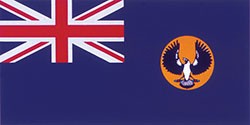
The Coat of Arms
Proclaimed on 19 April 1984, the state’s Coat of Arms replaces an earlier Coat of Arms conferred by King Edward VIII in 1936. The state badge, the piping shrike, appears on a shield in the centre of the Coat of Arms. The crest is of 4 sprigs of Sturt’s desert pea mounted on a wreath of red, blue and gold. The Coat of Arms stands on a grassy mount, on which stands grape vines, stalks of wheat and barley, citrus fruits, 2 cog wheels and a miners pick, along with a scroll bearing the name “South Australia”.
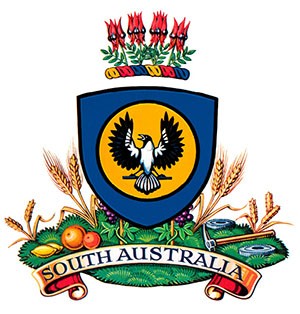
The badge
South Australia’s state badge, the piping shrike, was proclaimed on 14 January 1904. The piping shrike is an official name for the black and white bird most Australians call the white‑backed magpie. Almost every South Australian backyard is visited by the magpie and its sweet song. Magpies live in open forest and pasture country, eating insects, lizards and dead animals. They lay up to 5 green-blue or red-grey eggs in their deep nests of twigs, built in trees.
The piping shrike is the formal badge of the South Australian Government and is displayed on government buildings, brochures, stationery, flags, banners and sports uniforms for state teams.
The state colours
Red, blue and gold were proclaimed South Australia’s official colours on 25 November 1982.
The colour references are:
- Red: PANTONE® 199,
- Blue: PANTONE® 295, and
- Gold: PANTONE® 137.
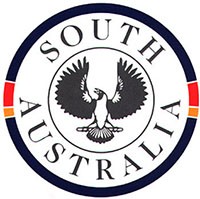
The floral emblem
Sturt’s desert pea
Sturt’s desert pea was adopted by the South Australian Government on 23 November 1961 as the state’s floral emblem.
Blood red, with a central blue-black blotch, Sturt’s desert pea flowers in autumn in clusters of up to 8, which are held up on a short stem. It is probably the most striking of all the plants of inland Australia, thriving in arid deserts and other areas receiving less than 380 millimetres of rain a year.
Colour variations have been found from pure white to pink and purple.
The seed is hard-coated. To be planted, it should first be soaked in hot, not boiling, water to germinate, rather like wattle seeds.
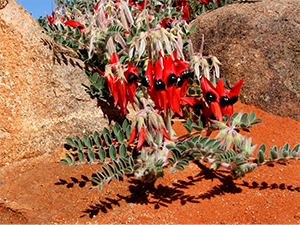
The animal emblem
The hairy-nosed wombat
The hairy-nosed wombat was adopted by the South Australian Government as its faunal emblem on 27 August 1970.
Don’t get in the way when a hairy-nosed wombat decides it’s going somewhere. The hairy-nosed wombat is a powerful, skilled digger and all muscle. Wombats make tracks for themselves, which they use on their night-time wanderings. They push their broad, blunt heads through or under most obstructions like farm fences. Some farmers make swinging doors in their fences which the wombats learn to push open.
The hairy-nosed wombat grows to be up to one metre long, weighing between 18 and 32 kilograms.
It is a plains dweller living in the dry areas of South Australia, with a few colonies in Western Australia.
It excavates deep, cool, humid burrows which are essential for it to survive in hot, desert conditions. Plant material is often its only source of water.
The wombat gives birth to a single young, only 2 centimetres long, between September and January. The young wombat remains confined in its mother’s backward-pointing pouch for 5 months. Then it starts to venture out to accustom itself to adult food.
Young wombats live in their mother’s burrows for another 2 years before they are driven out.
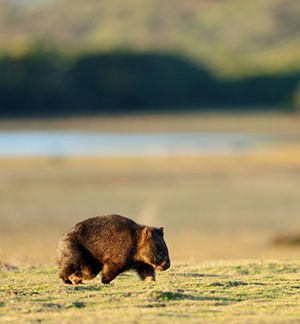
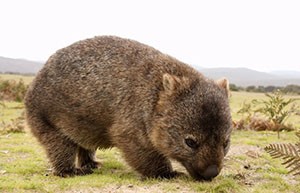
The gemstone emblem
The opal
Opal was adopted by the South Australian Government as the state gemstone emblem on 15 August 1985 and is shared with Australia as the national gemstone.
Eight out of ten of the world’s opal gemstones come from South Australia’s 3 major opal fields - Coober Pedy, Mintabie and Andamooka.

The state badge (piping shrike) and Coat of Arms symbols are for the official use of the Government of South Australia only. Under the Authorised Documents Act 1916, no person can print, publish or manufacture the symbols without permission.
Individuals or organisations can reproduce the faunal, floral and gemstone emblems, and state colours without seeking permission. The symbols cannot be used for commercial purposes.
For further information on the symbols of South Australia, and for permission to reproduce the state’s symbols, please contact:
Department of Premier and Cabinet
GPO Box 2343
Adelaide SA 5001
Phone: 08 8429 5135
Email: dpcprotocol@sa.gov.au
